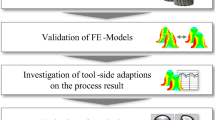Abstract
Modern automobiles are equipped with a large number of gear transmissions. In the powertrain, for example, they are used as multi-stage manual transmissions and in the interior for mirror and seat adjustment. Machining manufacturing processes—like gear hobbing and shaping—represent the state of the art in gear manufacturing due to high manufacturing accuracy and flexible machining possibilities. With regard to economic, ecological and technical aspects, cold forging offers a promising production technology. In conventional transverse and forward extrusion processes, the ejection process is a challenge due to high forces and a negative influence on the gearing accuracy. One variant of forward extrusion is the so-called “Samanta” process, whereby an additional ejection step is avoidable by sequential forming of the gears. For the establishment of this process in industry, the increase of the achievable gearing accuracy and the achievable tool life is of major relevance. Thus, a deeper process understanding as well as knowledge about the influences on the process results is beneficial. In this context, the aim of this research work is to produce spur and helical gears by the “Samanta”-process. In addition to the resulting component properties, the characteristics of the process are determined. On this basis, commonalities and differences in cold forging of spur and helical gears are investigated to gain a principle process understanding. These findings are also used to derive possible approaches for improving component and process properties in future research work. The results reveal that cold forging of spur and helical gears by the “Samanta”-process results in characteristic properties and specific challenges within the gear types. Furthermore, a geometric adaptation in the gearing area of the used die promises enormous potential for a positive influence on the process results for both types of gearing.











Similar content being viewed by others
References
Dudley DW (2013) Dudley’s handbook of practical gear design and manufacture. Springer, Berlin
Klocke F, Gorgels C, Kauffmann P, Herzhoff S, Schalster R, Stuckenberg A, Vasiliou V (2008) Trends in der Zahnradfertigung. In: Neugebauer R (Hrsg): Tagungsband zum 5. Chemnitzer Produktionstechnischen Kolloquium CPK: Zerspanung in Grenzbereichen, Berichte aus dem IWU, Band 46, pp 87–113
Bouzakis K-D, Lili E, Michailidis N, Friderikos O (2008) Manufacturing of cylindrical gears by generating cutting processes: a critical synthesis of analysis methods. Ann CIRP 57:676–696
Myeong-Sik J, Sang-Kon L (2013) Green manufacturing process for helical pinion gear using cold extrusion process. Int J Precis Eng Manuf 14:1007–1011
Keppler-Ott T (2002) Optimierung des Querfließpressens schrägverzahnter Stirnräder. Dissertation, Universität Stuttgart
Samanta SK (1976) Helical gear: a novel method of manufacturing it. In: Proceedings of NAMRC IV, Columbus, Ohio, USA: Batelle Columbus Laboratories, pp 199–205
Koll W (1990) Kaltfließpressen von Bauteilen mit Verzahnungen. Dissertation, RWTH Aachen
Felten K (2012) Verzahntechnik, 3. Aufl. Expert Verlag, Renningen
Standard DIN 50106 (1978) Testing of metallic materials—compression test at room temperature. Beuth, Berlin
Hockett J, Sherby O (1975) Large strain deformation of polycrystalline metals at low homologous temperatures. J Mech Phys Solids 23(2):87–98
VDI-Richtlinie (1984) Vorgespannte Preßwerkzeuge für das Kaltmassivumformen. Verein Deutscher Ingenieure (VDI), VDI 3176. VDI-Verlag, Düsseldorf
ICFG-Document (1982) Calculation methods for cold forging tools. International Cold Forging Group (ICFG), Doc. 5/82. Meisenbach, Bamberg
ICFG-Document (1987) General recommendations for design, manufacture and operational aspects of cold extrusion tools for steel components. International Cold Forging Group (ICFG), Doc. 6/82. Meisenbach, Bamberg
ICFG-Document (2004) Tool life and tool quality in cold forging, part two: quality requirements for tool manufacturing. International Cold Forging Group (ICFG), Doc. 16/04. Meisenbach, Bamberg
Lennartz J (1995) Kaltfließpressen von gerad- und schrägverzahnten Getriebewellen. Dissertation, RWTH Aachen
Klocke F, Nöthe T (2000) Fine machining of cold forging tools. In: Proceedings of 10th international cold forging congress, Fellbach, Germany, pp 175–191
ICFG-Document (1992) General aspects of tool design and tool materials for cold and warm forging. International Cold Forging Group (ICFG), Doc. 4/82. Meisenbach, Bamberg
ICFG-Document (1993) Coating of tools for bulk metalforming by PVD- and CVD-methods. International Cold Forging Group (ICFG), Doc. 9/92, Wire 43, pp 266–270
ICFG-Document (1991) Lubrication aspects in cold forging of carbon steels and low alloy steels. International Cold Forging Group (ICFG), Doc. 8/91. Meisenbach, Bamberg
Fritz AH, Schulze G (2018) Fertigungstechnik, 12. Auflage. Springer, Berlin
ISO 1328-1 (2013) Cylindrical gears—ISO system of accuracy—part 1: definitions and allowable values of deviations relevant to corresponding flanks of gear teeth. Beuth, Berlin
Feng W, Lv J, Hua L, Long H, Wang F (2017) Effect of relief-hole diameter on die elastic deformation during cold precision forging of helical gears. Procedia Eng 207:627–632
Lee Y, Lee J, Ishikawa T (2002) Analysis of the elastic characteristics at forging die for the cold forged dimensional accuracy. J Mater Process Technol 130–131:532–539
Melander A, Thoors H, Stenberg N, Ning M (2015) Spring back evaluation for high and ultra high strength sheet steels with the bending under tension machine. IntJ Mater Form 8:137–144
Bausch T (2015) Innovative Zahnradfertigung, 5. Auflage. Expert Verlag, Renningen
König W, Steffens K, Hofmann HW (1985) Gear production by cold forming. Ann CIRP 34(1):481–483
Acknowledgements
The authors would like to thank the Bavarian Research Foundation (BFS) for their financial support of the research project AZ-1252-16. Furthermore, the authors acknowledge the tool manufacturer I.Penkert for machining the dies as well as the company Schaeffler AG for providing the specimens and the scientifically discussions.
Author information
Authors and Affiliations
Corresponding author
Additional information
Publisher's Note
Springer Nature remains neutral with regard to jurisdictional claims in published maps and institutional affiliations.
Rights and permissions
About this article
Cite this article
Kiener, C., Merklein, M. Researching of commonalities and differences in cold forging of spur and helical gears. Prod. Eng. Res. Devel. 13, 391–397 (2019). https://doi.org/10.1007/s11740-019-00887-2
Received:
Accepted:
Published:
Issue Date:
DOI: https://doi.org/10.1007/s11740-019-00887-2




